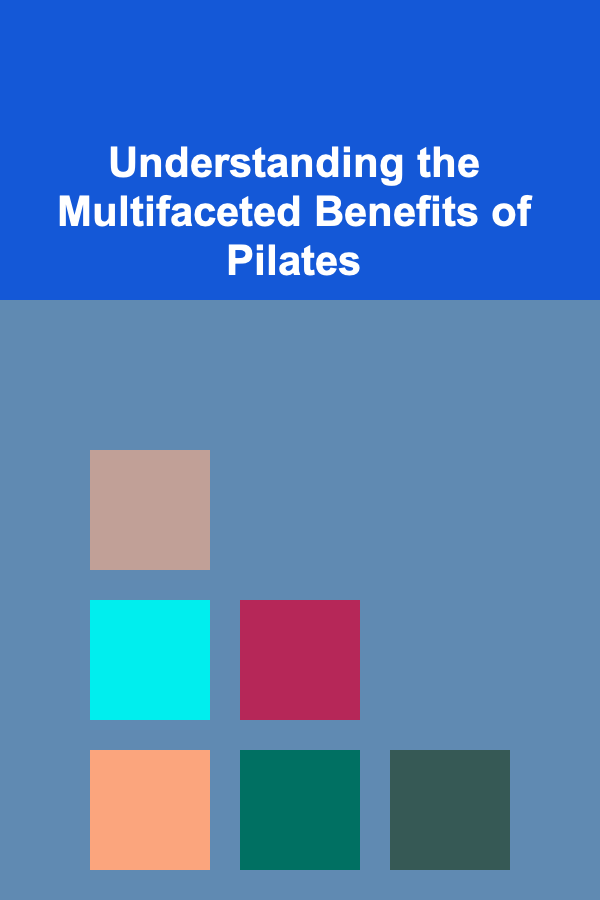
Understanding the Multifaceted Benefits of Pilates
ebook include PDF & Audio bundle (Micro Guide)
$12.99$11.99
Limited Time Offer! Order within the next:

Pilates, often perceived as a mere exercise trend, is, in reality, a sophisticated system of movement designed to enhance physical and mental well-being. Developed by Joseph Pilates in the early 20th century, this method goes beyond superficial fitness goals, focusing on core strength, body awareness, and controlled movement. To truly understand the benefits of Pilates, one must delve into its principles, explore its diverse applications, and consider the scientific evidence supporting its effectiveness.
The Core Principles of Pilates: A Foundation for Holistic Well-being
At the heart of Pilates lies a set of core principles that guide each exercise and contribute to its overall efficacy. These principles are not just theoretical concepts; they are practical guidelines that inform every movement, fostering a deeper connection between mind and body.
Centering: The Powerhouse of Pilates
Centering refers to the activation and engagement of the "powerhouse," a term Joseph Pilates used to describe the core muscles encompassing the abdomen, lower back, hips, and pelvic floor. This area serves as the foundation for all Pilates movements. By consciously engaging these muscles, practitioners develop a stable base from which to initiate and control movement, minimizing strain on other parts of the body. A strong powerhouse translates to improved posture, reduced back pain, and enhanced athletic performance. Understanding and mastering centering is crucial for reaping the full benefits of Pilates.
Concentration: Mindful Movement
Concentration emphasizes the importance of mental focus during exercise. Pilates is not about mindlessly going through the motions; it requires active engagement and awareness of every aspect of the movement. This includes paying attention to the specific muscles being used, the alignment of the body, and the quality of the breath. By cultivating concentration, individuals develop a heightened sense of body awareness, improving their ability to control and coordinate their movements. This mindful approach to exercise can also translate into improved focus and attention in other areas of life.
Control: Precision Over Force
Control is paramount in Pilates. Exercises are performed with precision and deliberate control, rather than relying on momentum or force. This requires a deep understanding of body mechanics and the ability to activate the correct muscles at the right time. By emphasizing control, Pilates minimizes the risk of injury and promotes efficient movement patterns. It's about quality over quantity, ensuring that each repetition is executed with intention and accuracy.
Precision: Alignment and Accuracy
Precision builds upon the principle of control, emphasizing the importance of proper alignment and accuracy in each movement. This involves paying attention to the position of the spine, pelvis, shoulders, and limbs, ensuring that they are properly aligned to minimize stress and optimize muscle activation. Precision requires a keen awareness of body mechanics and the ability to make subtle adjustments to maintain optimal alignment. Over time, this practice can improve posture, reduce pain, and enhance overall movement efficiency.
Breath: The Rhythm of Movement
Breath is an integral part of Pilates, serving as a key component in controlling and coordinating movement. Specific breathing patterns are used in conjunction with different exercises to enhance core stability, facilitate muscle activation, and promote relaxation. Pilates breathing typically involves inhaling deeply into the ribcage and exhaling fully to engage the abdominal muscles. The breath acts as a metronome, guiding the rhythm of the movement and promoting a sense of flow and control. Proper breathing also helps to oxygenate the blood and calm the nervous system.
Flow: Seamless Transitions
Flow refers to the smooth and seamless transitions between exercises. Pilates is not about performing isolated movements; it's about creating a fluid and continuous sequence of exercises that challenge the body in a holistic way. By emphasizing flow, Pilates promotes coordination, balance, and overall movement efficiency. Each exercise builds upon the previous one, creating a synergistic effect that enhances the benefits of the entire workout. Flow requires a deep understanding of the exercises and the ability to connect them in a meaningful way.
Physical Benefits: Transforming the Body from Within
The physical benefits of Pilates extend far beyond simply building strength or losing weight. It is a transformative practice that addresses fundamental aspects of physical fitness, leading to significant improvements in posture, flexibility, and overall body function.
Core Strength and Stability: The Foundation of Movement
Pilates is renowned for its ability to build core strength and stability. The exercises specifically target the deep core muscles, including the transverse abdominis, multifidus, and pelvic floor muscles. Strengthening these muscles provides a stable base of support for the spine, improving posture, reducing back pain, and enhancing athletic performance. A strong core acts as a natural corset, protecting the spine from injury and allowing for more efficient movement.
Improved Posture: Aligning the Body for Optimal Function
Poor posture is a common problem in today's world, often resulting from sedentary lifestyles and repetitive movements. Pilates helps to correct postural imbalances by strengthening the muscles that support proper alignment and releasing tension in tight muscles. By improving posture, Pilates can reduce pain, improve breathing, and enhance overall body function. A well-aligned body is more efficient and less prone to injury.
Increased Flexibility and Range of Motion: Moving with Ease
Pilates incorporates a variety of exercises that stretch and lengthen the muscles, increasing flexibility and range of motion. This is particularly beneficial for individuals who are stiff or inflexible due to age, injury, or inactivity. Improved flexibility allows for greater ease of movement, reducing the risk of injury and enhancing athletic performance. Pilates also promotes joint mobility, which is essential for maintaining healthy joints throughout life.
Enhanced Muscle Tone and Definition: Sculpting a Balanced Physique
While Pilates is not primarily a strength-training method, it can significantly improve muscle tone and definition. The exercises engage multiple muscle groups simultaneously, promoting balanced muscle development throughout the body. Pilates emphasizes long, lean muscles, rather than bulky muscles, resulting in a sculpted and toned physique. The focus on core strength and stability also contributes to a more defined and streamlined appearance.
Reduced Pain and Injury Risk: Protecting the Body from Harm
Pilates can be a highly effective treatment for chronic pain conditions, particularly back pain and neck pain. By strengthening the core muscles, improving posture, and increasing flexibility, Pilates helps to stabilize the spine, reduce stress on the joints, and alleviate pain. It can also be used as a preventative measure to reduce the risk of injury, particularly for athletes and individuals who engage in repetitive activities. The emphasis on controlled movement and proper alignment minimizes the risk of strain and injury.
Improved Balance and Coordination: Moving with Confidence
Pilates challenges balance and coordination through a variety of exercises that require stability and control. By improving these skills, Pilates can reduce the risk of falls, enhance athletic performance, and improve overall movement efficiency. Balance and coordination are essential for performing everyday activities with confidence and ease. Pilates helps to develop the neuromuscular connections that are necessary for maintaining balance and coordinating movement.
Mental and Emotional Benefits: Cultivating Mind-Body Harmony
The benefits of Pilates extend beyond the physical realm, encompassing mental and emotional well-being. The practice fosters a deep connection between mind and body, promoting relaxation, reducing stress, and enhancing self-awareness.
Stress Reduction and Relaxation: Calming the Nervous System
Pilates can be a highly effective stress-reduction technique. The focus on breath, concentration, and controlled movement promotes relaxation and calms the nervous system. The mindful approach to exercise encourages individuals to focus on the present moment, reducing anxiety and promoting a sense of calm. Pilates can also help to release tension in the muscles, further contributing to relaxation.
Improved Body Awareness: Connecting with the Inner Self
Pilates cultivates a heightened sense of body awareness. By paying attention to the sensations in the body during exercise, individuals become more aware of their posture, alignment, and movement patterns. This increased awareness can translate into improved body mechanics in everyday life, reducing the risk of injury and enhancing overall function. It also promotes a deeper connection with the inner self, fostering a greater sense of self-acceptance and body positivity.
Enhanced Focus and Concentration: Sharpening the Mind
The concentration required during Pilates exercises can improve focus and concentration in other areas of life. By training the mind to stay present and engaged, individuals can develop the ability to focus more effectively on tasks and activities. This can lead to improved productivity, better decision-making, and a greater sense of mental clarity.
Increased Self-Esteem and Confidence: Embracing Inner Strength
As individuals experience the physical and mental benefits of Pilates, they often develop a greater sense of self-esteem and confidence. The feeling of accomplishment that comes from mastering challenging exercises, combined with the improved body awareness and physical appearance, can boost self-confidence and promote a more positive self-image. Pilates empowers individuals to take control of their health and well-being, fostering a sense of inner strength and resilience.
Improved Mood and Emotional Regulation: Finding Balance Within
Studies have shown that exercise, including Pilates, can improve mood and emotional regulation. Exercise releases endorphins, which have mood-boosting effects. Pilates can also help to reduce symptoms of anxiety and depression. The combination of physical activity, mindful focus, and stress reduction promotes emotional well-being and a greater sense of inner balance.
Pilates for Specific Populations: Adapting the Practice to Individual Needs
One of the strengths of Pilates is its adaptability. The exercises can be modified to suit individuals of all ages and fitness levels, making it a safe and effective practice for a wide range of populations.
Pilates for Seniors: Maintaining Mobility and Independence
Pilates is an excellent form of exercise for seniors. It can help to maintain mobility, improve balance, and reduce the risk of falls. The low-impact nature of Pilates makes it gentle on the joints, while the focus on core strength and stability helps to protect the spine and improve posture. Pilates can also help to alleviate pain and stiffness associated with arthritis and other age-related conditions. Modified Pilates exercises can be performed sitting or lying down, making it accessible to individuals with limited mobility.
Pilates for Athletes: Enhancing Performance and Preventing Injury
Pilates is widely used by athletes to enhance performance and prevent injury. The focus on core strength, flexibility, and body awareness can improve athletic performance in a variety of sports. Pilates helps to develop the deep stabilizing muscles that are essential for efficient movement and injury prevention. It can also improve balance, coordination, and agility, all of which are important for athletic success. Pilates can be incorporated into an athlete's training program to address specific weaknesses and improve overall performance.
Pilates for Pregnant Women: Supporting a Healthy Pregnancy and Postpartum Recovery
Pilates is a safe and effective form of exercise for pregnant women. Modified Pilates exercises can help to strengthen the core muscles, which are essential for supporting the growing belly and maintaining good posture. Pilates can also help to alleviate back pain and other pregnancy-related discomforts. Postpartum Pilates can help to restore core strength and stability after childbirth, facilitating a quicker recovery and improving overall well-being. It's crucial to consult with a healthcare professional before starting Pilates during pregnancy.
Pilates for Individuals with Injuries: Rehabilitating and Restoring Function
Pilates can be used as a rehabilitative tool for individuals recovering from injuries. The controlled and precise movements can help to strengthen weakened muscles, improve range of motion, and reduce pain. Pilates is often recommended by physical therapists as part of a comprehensive rehabilitation program. The exercises can be modified to accommodate individual limitations and gradually progress as the individual recovers. It is important to work with a qualified Pilates instructor who is experienced in working with individuals with injuries.
Pilates for Children and Adolescents: Promoting Healthy Development
Pilates can be beneficial for children and adolescents, promoting healthy development and preventing postural problems. The exercises can help to improve posture, strengthen core muscles, and increase flexibility. Pilates can also help to improve body awareness and coordination, which are important for developing motor skills. It is important to adapt the exercises to the age and developmental level of the child or adolescent. Pilates can be a fun and engaging way to promote physical activity and healthy habits in young people.
Scientific Evidence: Backing Up the Claims
While anecdotal evidence and personal testimonials abound, the benefits of Pilates are increasingly supported by scientific research. Studies have investigated the effects of Pilates on various aspects of physical and mental health, providing evidence for its efficacy.
Research on Back Pain: Finding Relief Through Pilates
Numerous studies have shown that Pilates can be effective in reducing back pain. A meta-analysis published in the Journal of Orthopaedic & Sports Physical Therapy found that Pilates was significantly more effective than usual care in reducing pain and improving function in individuals with chronic low back pain. The researchers concluded that Pilates is a safe and effective treatment option for back pain.
Studies on Core Strength and Stability: Validating the Powerhouse
Research has confirmed that Pilates effectively strengthens the core muscles. A study published in the Journal of Strength and Conditioning Research found that Pilates training significantly increased abdominal muscle strength and endurance in healthy adults. The researchers suggested that Pilates can be a valuable tool for improving core stability and preventing injuries.
Evidence on Postural Improvement: Standing Tall with Pilates
Studies have demonstrated that Pilates can improve posture. A study published in the Journal of Bodywork and Movement Therapies found that Pilates training significantly improved postural alignment in individuals with poor posture. The researchers concluded that Pilates can be an effective intervention for correcting postural imbalances.
Research on Flexibility and Range of Motion: Moving More Freely
Research supports the claim that Pilates increases flexibility and range of motion. A study published in the Archives of Physical Medicine and Rehabilitation found that Pilates training significantly improved flexibility in older adults. The researchers suggested that Pilates can be a valuable tool for maintaining flexibility and preventing age-related decline in mobility.
Studies on Mental Health Benefits: A Holistic Approach to Well-being
Research suggests that Pilates can have positive effects on mental health. A study published in the Journal of Alternative and Complementary Medicine found that Pilates training reduced symptoms of anxiety and depression in women with fibromyalgia. The researchers concluded that Pilates can be a beneficial adjunctive therapy for improving mental health.
It is important to note that while the research on Pilates is growing, more high-quality studies are needed to further investigate its effects on various populations and conditions. However, the existing evidence provides a solid foundation for understanding the potential benefits of this comprehensive exercise system.
Conclusion: Embracing the Transformative Power of Pilates
Understanding the benefits of Pilates requires a deeper appreciation of its principles, its diverse applications, and the scientific evidence supporting its effectiveness. It is not simply about physical fitness; it is a holistic practice that addresses the interconnectedness of mind, body, and spirit. By focusing on core strength, body awareness, and controlled movement, Pilates empowers individuals to transform their bodies from within, achieving improved posture, increased flexibility, reduced pain, and enhanced overall well-being. Whether you are a senior seeking to maintain mobility, an athlete striving to enhance performance, or simply someone looking to improve your physical and mental health, Pilates offers a safe, effective, and transformative path to a healthier and more fulfilling life. Embracing the principles of Pilates and incorporating it into your routine can unlock a world of benefits, leading to a stronger, more balanced, and more resilient you.

How to Choose the Right Lighting for Your Living Room
Read More
How to Create a Cozy Winter Wonderland at Home
Read More
How to Create a Space-Saving Design for a Multi-Use Room
Read More
How to Set Up a Smart Security System for Your Home
Read More
How To Conduct Market Research Effectively
Read More
How to Navigate Small Claims Court: A Lawyer's Perspective
Read MoreOther Products

How to Choose the Right Lighting for Your Living Room
Read More
How to Create a Cozy Winter Wonderland at Home
Read More
How to Create a Space-Saving Design for a Multi-Use Room
Read More
How to Set Up a Smart Security System for Your Home
Read More
How To Conduct Market Research Effectively
Read More